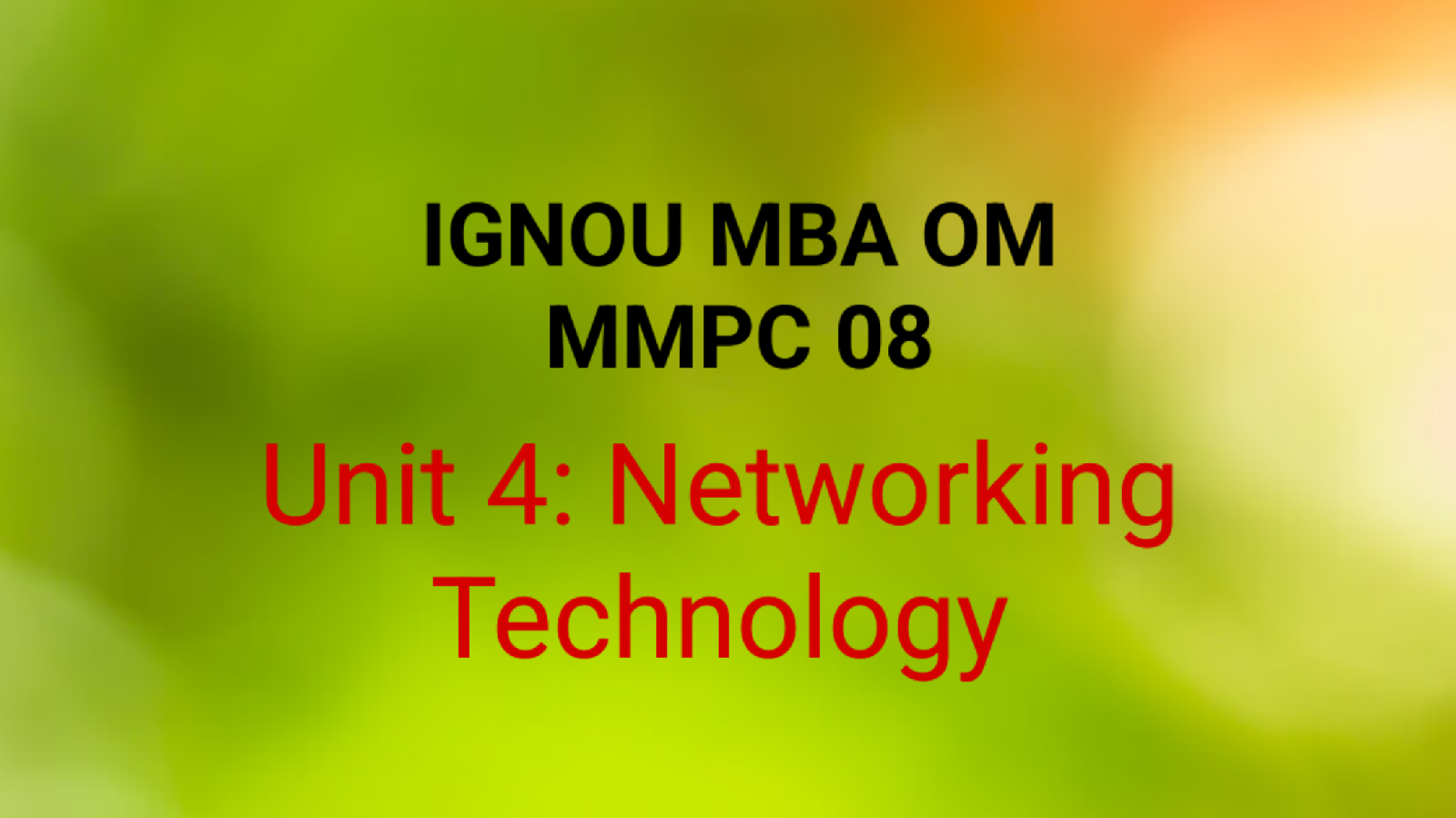IGNOU MBA MMPC-08: Information Technology for Managers
Unit 4: Networking Technology
Introduction
Networking technology plays a vital role in modern business environments by enabling seamless communication, data exchange, and resource sharing. This unit explores the fundamentals of networking, types of networks, protocols, network security, and emerging trends.
1. Basics of Networking
1.1 Definition of Networking
Networking refers to the interconnection of multiple computing devices to share resources and information efficiently.
1.2 Components of a Network
- Nodes (Devices) – Computers, printers, smartphones, IoT devices.
- Network Media – Cables, fiber optics, radio waves.
- Network Interface Cards (NICs) – Hardware enabling communication.
- Switches & Hubs – Devices that manage network traffic.
- Routers – Directs data between networks.
- Modems – Converts digital signals to analog and vice versa.
2. Types of Networks
2.1 Local Area Network (LAN)
- Covers a small geographic area (e.g., offices, schools).
- High-speed data transfer.
- Example: Ethernet-based networks.
2.2 Wide Area Network (WAN)
- Covers large geographic areas.
- Uses public infrastructure like telephone lines.
- Example: The Internet.
2.3 Metropolitan Area Network (MAN)
- Covers a city or a large campus.
- Higher speed than WAN but smaller coverage.
- Example: Citywide Wi-Fi networks.
2.4 Personal Area Network (PAN)
- Covers an individual's workspace.
- Example: Bluetooth connections between devices.
2.5 Virtual Private Network (VPN)
- Secure private network over the Internet.
- Provides encrypted connections.
- Used for remote access.
3. Network Topologies
3.1 Types of Network Topologies
- Bus Topology – Single central cable; failure affects the entire network.
- Star Topology – Devices connect to a central hub; easy troubleshooting.
- Ring Topology – Devices form a ring; failure of one device can affect the entire network.
- Mesh Topology – Each device connects to every other; high reliability.
- Hybrid Topology – Combination of multiple topologies.
4. Network Protocols and Standards
4.1 Introduction to Protocols
Protocols define communication rules between devices.
4.2 Common Networking Protocols
- Transmission Control Protocol/Internet Protocol (TCP/IP) – Core Internet protocol.
- Hypertext Transfer Protocol (HTTP/HTTPS) – Web browsing.
- File Transfer Protocol (FTP) – File exchange between computers.
- Simple Mail Transfer Protocol (SMTP) – Email transmission.
- Domain Name System (DNS) – Converts domain names to IP addresses.
- Internet Protocol Version 6 (IPv6) – Next-generation IP addressing.
5. Wireless Networking
5.1 Wireless Communication Technologies
- Wi-Fi – Wireless LAN communication.
- Bluetooth – Short-range device communication.
- Near Field Communication (NFC) – Contactless payments.
- 5G Networks – High-speed mobile communication.
- Satellite Communication – Global coverage, used in remote areas.
6. Network Security
6.1 Importance of Network Security
Network security protects data integrity, confidentiality, and availability.
6.2 Common Security Threats
- Malware – Viruses, worms, trojans.
- Phishing – Fraudulent attempts to obtain sensitive information.
- Denial of Service (DoS) Attacks – Overloading networks to cause failures.
- Man-in-the-Middle Attacks – Interception of data transmission.
6.3 Security Measures
- Firewalls – Block unauthorized access.
- Encryption – Protects data with cryptographic methods.
- Intrusion Detection Systems (IDS) – Detects network anomalies.
- Multi-Factor Authentication (MFA) – Adds extra security layers.
7. Emerging Trends in Networking Technology
7.1 Internet of Things (IoT) in Networking
IoT enables smart devices to connect and share data in real time.
7.2 Cloud Networking
Cloud-based networking solutions improve flexibility and scalability.
7.3 Software-Defined Networking (SDN)
Centralized network management enhances efficiency.
7.4 Edge Computing
Processes data closer to its source to reduce latency.
8. Practical Applications and Experiments
8.1 Experiment: Setting Up a Local Area Network (LAN)
Objective: Configure and test a LAN network.
Steps:
- Connect multiple computers using a switch.
- Assign IP addresses to each device.
- Test communication using the "ping" command.
8.2 Experiment: Configuring a Wi-Fi Network
Objective: Set up a secure wireless network.
Steps:
- Access the router’s web interface.
- Configure SSID and password.
- Enable encryption (WPA2/WPA3).
- Connect devices and test.
9. Assignment Questions
- Explain different types of computer networks with examples.
- Describe various network topologies and their advantages.
- How do firewalls contribute to network security?
- Compare IPv4 and IPv6 protocols.
- Discuss the role of cloud networking in modern enterprises.
10. Self-Study Questions
- What is the difference between LAN and WAN?
- How does a router function in a network?
- What are the major security risks in wireless networking?
- Explain the role of DNS in Internet communication.
- Discuss the future trends in networking technology.
11. Exam Questions
Short Answer Questions:
- Define networking.
- List two examples of networking devices.
- What is the function of a switch in a network?
- Explain the concept of VPN.
- Name two wireless communication technologies.
Long Answer Questions:
- Explain the role of TCP/IP in networking.
- Compare and contrast different types of network topologies.
- Discuss the significance of network security and common threats.
- How do IoT and 5G impact modern networking?
- Explain the working principles of cloud networking and its advantages.
Conclusion
This unit provides a detailed understanding of networking technologies, their applications, security measures, and emerging trends. Networking is a critical component for businesses and organizations to ensure efficient communication and data management.
Here is the complete class for Unit 4: Networking Technology of IGNOU MBA MMPC-08. It covers all essential topics, including networking basics, protocols, security, experiments, and exam-related questions. Let me know if you need any modifications or additional details!





















